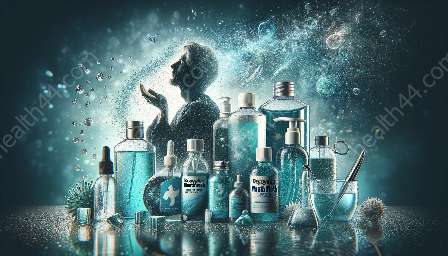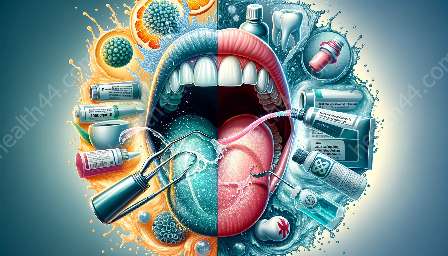Mouthwash is a popular oral hygiene product that is used to kill bacteria in the mouth and freshen breath. It works by containing active ingredients that target and eliminate harmful bacteria, promoting oral health. Understanding how mouthwash achieves this, and the proper ways to use mouthwash can significantly benefit one's oral hygiene routine. This topic cluster will delve into the mechanisms of mouthwash in killing bacteria, discuss its benefits and usage, and differentiate between mouthwash and rinses for comprehensive oral care.
How Does Mouthwash Work in Killing Bacteria?
Mouthwash employs various active ingredients that work together to kill bacteria and prevent plaque buildup. The primary functions of mouthwash in killing bacteria are:
- Antimicrobial Action: Most mouthwashes contain antimicrobial agents such as cetylpyridinium chloride (CPC), chlorhexidine, or essential oils like eucalyptol, thymol, and menthol. These agents effectively target and kill the bacteria present in the oral cavity, reducing the risk of oral infections.
- Disruption of Biofilm: Biofilm is a thin film of bacteria that adheres to the teeth and gums, contributing to plaque formation. Mouthwash disrupts the biofilm, preventing the bacteria from adhering to the surfaces of the mouth and reducing the formation of dental plaque.
- Neutralizing Acidity: Bacteria in the mouth produce acids that can lead to tooth decay and erosion. Certain mouthwashes contain alkaline agents that help neutralize the acidity, creating an inhospitable environment for bacteria to thrive.
Benefits of Using Mouthwash
Regular use of mouthwash offers several benefits beyond just killing bacteria. These include:
- Improved Oral Hygiene: Mouthwash complements brushing and flossing by reaching areas that may be missed during regular oral care, providing comprehensive protection against bacteria and plaque.
- Fresh Breath: Mouthwash helps in neutralizing odors and promoting fresh breath by eliminating bacteria and food particles that can lead to bad breath.
- Reduced Risk of Oral Diseases: The antimicrobial action of mouthwash reduces the risk of gum disease, cavities, and other oral infections, contributing to overall oral health.
How to Use Mouthwash
Proper usage of mouthwash is essential to maximize its effectiveness and reap its benefits. Here are the steps to use mouthwash effectively:
- Choose the Right Mouthwash: Select a mouthwash that addresses your specific oral health needs, such as plaque control, gum care, or sensitivity relief. Read the instructions and use as directed.
- Measure the Correct Amount: Pour the recommended amount of mouthwash into a cup, usually around 20-30 milliliters, and avoid diluting with water to maintain its potency.
- Swish and Rinse: Tilt your head back, swish the mouthwash around your mouth for 30-60 seconds, making sure to reach all areas including the teeth, gums, and tongue. Then, spit out the mouthwash without swallowing.
- Avoid Eating and Drinking: Refrain from eating or drinking for at least 30 minutes after using mouthwash to allow its active ingredients to continue working effectively.
Mouthwash and Rinses: Understanding the Differences
Mouthwash and rinses are often used interchangeably, but they serve different purposes in oral care:
- Mouthwash: Typically, mouthwash contains active ingredients aimed at killing bacteria and freshening breath. It is intended for overall oral hygiene and often has specific functions such as plaque control or gum care.
- Rinses: Rinses, also known as mouth rinses or mouth rinsing solutions, are primarily used to rinse the mouth after brushing and flossing. They usually do not contain active antibacterial agents and are more focused on providing a clean and refreshing sensation.
Understanding these differences can help in choosing the right product for individual oral care needs.









